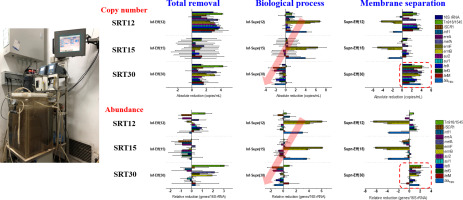Environment International ( IF 10.3 ) Pub Date : 2018-06-12 , DOI: 10.1016/j.envint.2018.06.008 Qianwen Sui , Chao Jiang , Junya Zhang , Dawei Yu , Meixue Chen , Yawei Wang , Yuansong Wei

|
Swine wastes are the reservoir of antibiotic resistance genes (ARGs), which can potentially spread from swine farms to the environment. This study establishes a sequencing-batch membrane bioreactor (SMBR) for ARG removal from swine wastewater, and analyzes the effect of biological treatment and membrane separation on the ARG removal at different solid retention times (SRTs). The SMBR removed 2.91 logs (copy number) of ARGs at a short SRT (12 days). Raising the SRT reduced the removal rates of the detected genes by the biological treatment. Under the relative long SRT (30 days), ARGs and mobile genetic elements (MGEs) were maximized within the reactor and were well removed by membrane separation, with the average genes removal rate of 2.95 (copy number) and 1.18 logs (abundance). At the relatively low SRT, the biological treatment showed the dominant ARG removal effect, while the membrane separation took the advantages of ARG removal especially at the relatively long SRT. The ARG profile was related to the shift of the microbial community structure. The ARGs coexisted with the functional bacteria (ammonia oxidizing bacteria, nitrite oxidizing bacteria and denitrifiers), suggesting they are hosted by the functional bacteria.
中文翻译:

通过顺序分批膜生物反应器处理过程,生物处理或膜分离是否会降低猪废水中的抗生素抗性基因?
猪粪是抗生素抗性基因(ARG)的储存库,它有可能从猪场传播到环境中。这项研究建立了一个测序批膜生物反应器(SMBR)去除猪废水中的ARG,并分析了生物处理和膜分离对不同固相保留时间(SRT)去除ARG的影响。SMBR在短的SRT(12天)内删除了2.91日志(副本号)ARG。升高SRT降低了通过生物处理对检测到的基因的去除率。在相对较长的SRT(30天)下,反应堆中的ARG和移动遗传元件(MGE)最大化,并通过膜分离将其很好地去除,平均基因去除率为2.95(拷贝数)和1.18 log(丰度)。在相对较低的SRT下,生物处理显示出主要的ARG去除效果,而膜分离则利用了ARG去除的优势,尤其是在相对较长的SRT下。ARG资料与微生物群落结构。ARG与功能性细菌(氨氧化性细菌,亚硝酸盐氧化性细菌和反硝化剂)共存,表明它们是功能性细菌的宿主。











































 京公网安备 11010802027423号
京公网安备 11010802027423号